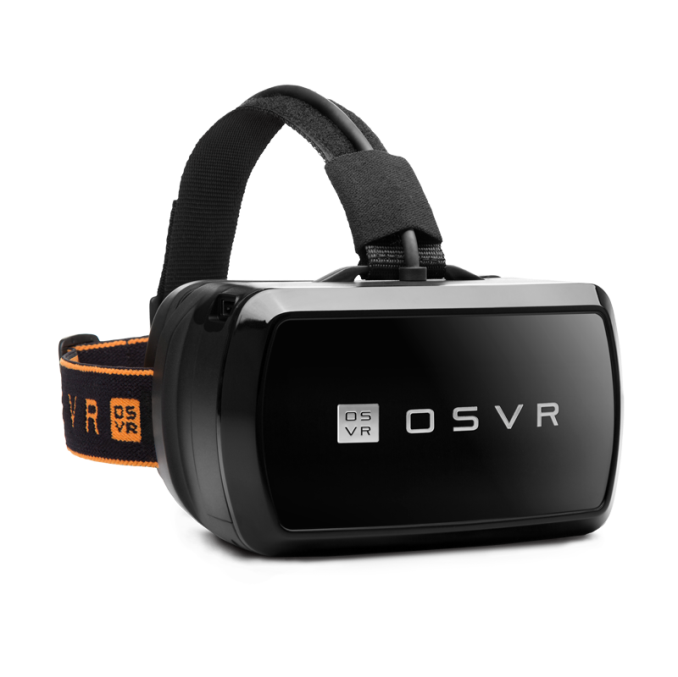OSVR Updates Hardware And Software For VR Dev Kits
by Brett Howse on September 4, 2015 3:00 AM EST
OSVR is Open Source Virtual Reality, which is trying to stake its claim in the yet unrealized Virtual Reality landscape. Today they have announced that they have updated their Hacker Development Kit (HDK) to version 1.3, and they have also updated their software to leverage VR technology from NVIDIA and to provide an application profiler.
Pre-orders for the HDK v1.3 are going to go live on the first of October, and shipments will begin later in the month. The new kit improves the optics and display modules. The optics module is very important in VR because of how close the displays sit in relation to your eye. Without optics, it is very difficult to focus on something so close. The new optics expands the eyebox which provides sharper images without having to use independent adjustable lenses. The optics module will also offer individual eye focus which will let people who wear glasses adjust each eye to let them use the kit without glasses.
The display module has also been upgraded, and it is now a 1920x1080 resolution 5.5-inch silver screen OLED display which has a 120 Hz refresh rate. Low persistence is the key to VR which is one of the main reasons for OLED on these devices, and the higher refresh rate will likely allow them to do what Oculus is doing to improve persistence, which is to interleave a black frame between images.
OSVR has also worked with NVIDIA to leverage their Gameworks VR technology. Ryan covered this when it was first announced, so I will direct you there to get an overview for what Gameworks VR brings to the table. Specifically for OSVR they have pointed to a few parts of this technology which they are leveraging. Direct Mode lets the NVIDIA driver treat the VR headset as a head mounted display rather than a traditional PC monitor which helps with plug and play support and compatibility. Front Rendering Buffering lets the GPU render directly to the front buffer which reduces latency, and Context Priority lets the developer have more control over the GPU scheduling.
OSVR has also launched a Performance Profiler which uses Event Tracing for Windows to track the performance of a VR application at all stages, allowing developers to locate bottlenecks which may cause stuttering in a typical PC game, but would quickly cause a loss of immersion in a VR scenario.
OSVR is up against some pretty big names, but they have added over 60 new supporters to their open source solution. Content is going to be the key to their success, as it will be for any of the VR headsets.
Source: Razer












6 Comments
View All Comments
jjj - Friday, September 4, 2015 - link
With Oculus and likely others going for a closed ecosystem we really need some open standards allowing for sanely priced hardware and content diversity.They should try to get some monitor makers and Chinese phone makers on board. Monitor makers will lose business if they don't join this game and Chinese phone makers might have trouble getting into glasses on their own.
twin - Friday, September 4, 2015 - link
Except Oculus isn't "going for a closed ecosystem", and their pricing will almost surely be cheaper than any similar quality product produced in low volume.hyno111 - Friday, September 4, 2015 - link
There are several Chinese VR headsets right now. And they claim to be "compatible with DK1 and DK2", while maintaining a reasonable price.The screen varies from 5.98-inch IPS(!)/2560*1440/75Hz to OLED/1080P/75Hz.
And most of them are about 200$ to 300$, through I am not sure when will they managed to compatible with recent Oculus Runtime update..
There are more Chinese "VR headsets" using Android phone as screen, they are actually useable for "immersion movie experience" at 20$.
It is rumored Allwinner and Rockchip both have experimental VR headsets awaiting mass production.
jjj - Friday, September 4, 2015 - link
Oculus is as closed as it can be and they are pushing it way too far.Their hardware won't even be close to decently priced, just the fact that they included the external cam sensor and the Xbox controller makes that impossible. The peripherals pretty much double the costs.
Oculus is dead, they made all the bad decisions they could have.
JKflipflop98 - Sunday, September 6, 2015 - link
You are an ignorant fool.edzieba - Friday, September 4, 2015 - link
"the higher refresh rate will likely allow them to do what Oculus is doing to improve persistence, which is to interleave a black frame between images."That is NOT how low persistence driving works! What Oculus and Valve/HTCX are doing is not illuminaing the display for the entire refresh period for 120Hz, that would be 8.3ms) for for a mere 1-2ms, then keeping the screen plant for the remainder of the refresh period.
Because the image displayed on the screen if only 'correct' for an instantaneous point in time, it is preferable to show it for the shortest period possible. The lower the latency between final warp and display, the shorter the time you need to predict the future head movement over to get the image you display at that point in time as close to correct as possible.